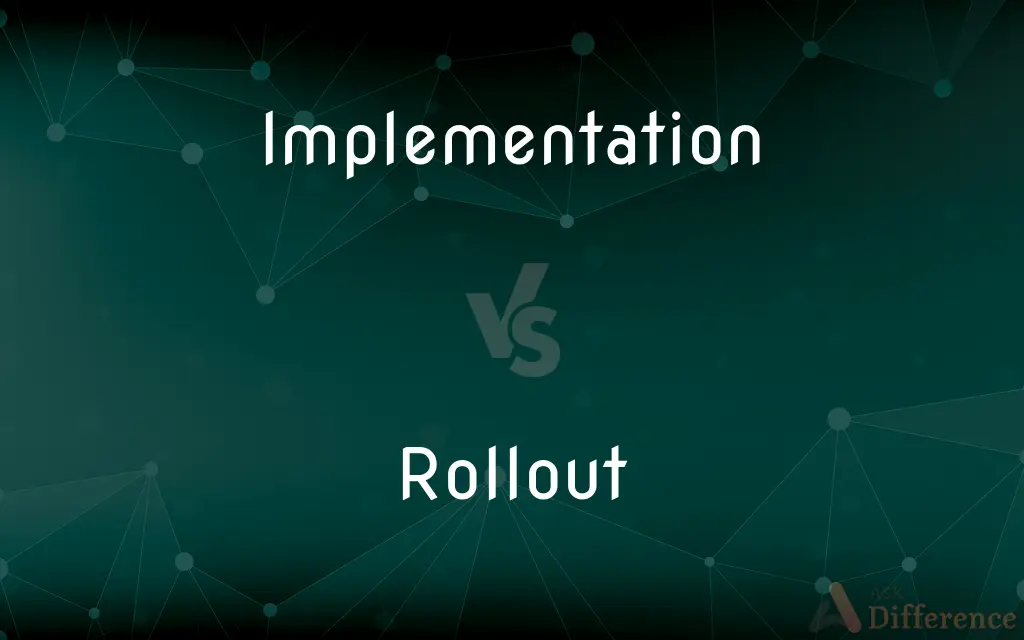Implementation vs. Rollout — What's the Difference?
By Urooj Arif & Maham Liaqat — Updated on April 3, 2024
Implementation is the process of putting a plan or system into operation, focusing on execution details, while rollout refers to the public or large-scale introduction of a new product or system.

Difference Between Implementation and Rollout
Table of Contents
ADVERTISEMENT
Key Differences
While implementation is a broad term that encompasses all the steps involved in executing a plan, including problem-solving and adjustments along the way, rollout is more narrowly focused on the distribution and adoption phase. Rollout strategies are designed to maximize adoption and minimize disruption, often involving training, support, and feedback mechanisms to facilitate a smooth transition for users.
The term "implementation" is used across various fields, from software development to policy enactment, indicating the practical application of ideas, whereas "rollout" is more commonly associated with products, services, and technology, emphasizing the importance of how these offerings are introduced to ensure successful adoption.
Implementing a new system or policy requires meticulous planning, testing, and adjustment to integrate effectively into existing operations. The rollout is a critical stage where stakeholders get to interact with the new system or product, making it essential to manage first impressions and user experience to foster positive reception and feedback.
Understanding the distinction between implementation and rollout helps in effectively communicating the stages of introducing new systems, policies, or products, ensuring clarity in project plans and strategies.
Comparison Chart
Definition
The process of executing a plan, system, or policy.
The process of introducing a new product or system to the public or specific user groups.
ADVERTISEMENT
Focus
Execution details, integration, and functionality.
Public introduction, marketing, and phased distribution.
Scope
Broad, covering all steps from planning to execution.
Narrow, focusing specifically on introduction and adoption.
Associated Fields
Varied, including software development, policy implementation, etc.
Primarily related to new products, services, and technology.
Key Concerns
Ensuring the system or plan works as intended.
Maximizing adoption and minimizing disruption.
Compare with Definitions
Implementation
The action of putting a decision or plan into effect.
The implementation of the new software system took six months.
Rollout
Often involves marketing strategies.
The marketing team developed a campaign to support the rollout.
Implementation
Involves detailed planning and problem-solving.
Implementation challenges were addressed through a series of team meetings.
Rollout
May be implemented in stages.
The software's rollout included beta testing with select users before the public launch.
Implementation
Requires monitoring and adjusting.
Ongoing implementation efforts include regular updates and feedback sessions.
Rollout
The introduction of a new product or system to the market.
The rollout of the latest smartphone model was highly anticipated.
Implementation
Applies to a wide range of contexts.
Policy implementation requires careful consideration of legal and social impacts.
Rollout
Aims to ensure a positive reception.
Training sessions were part of the rollout plan to familiarize users with the new system.
Implementation
Ensures integration into existing systems.
The team focused on the smooth implementation of the new scheduling tool.
Rollout
Focuses on distribution and adoption.
The company planned a phased rollout for its new service to gauge user feedback.
Implementation
Implementation is the realization of an application, or execution of a plan, idea, model, design, specification, standard, algorithm, or policy.
Rollout
The introduction of a new product, service, or policy to the public.
Implementation
The process of putting a decision or plan into effect; execution
She was responsible for the implementation of the plan
Rollout
(Football) A play in which the quarterback runs toward a sideline after receiving the snap with the intention of passing the ball.
Implementation
A tool, utensil, or other piece of equipment used in doing work
A gardening implement.
Rollout
An act of rolling out; gradual deployment.
Implementation
An article used to outfit or equip someone
Ecclesiastical implements.
Rollout
(aviation) The phase of a landing after touchdown but before the aircraft slows to taxi speed.
The pilot kept a vigilant eye out for runway obstructions throughout the rollout.
Implementation
A means of achieving an end; an instrument or agent.
Rollout
(American football) A play in which a quarterback moves toward the sideline before attempting to pass.
Implementation
To put into practical effect; carry out
Implement the new procedures.
Rollout
(backgammon) A form of analysis in which the same position is played many times (with different dice rolls) and the various outcomes are recorded.
Implementation
To supply with implements.
Rollout
(poker) A game variant in which players progressively reveal their cards.
Implementation
The process of moving an idea from concept to reality. In business, engineering and other fields, implementation refers to the building process rather than the design process.
Now that the requirements are complete we can move on to implementation.
Rollout
(HVAC) A malfunction in a gas furnace where gas burns outside the combustion chamber. Such a malfunction can cause damage to the furnace, carbon monoxide poisoning, or start a fire.
Implementation
(electronics) A result of implementing something; a finished product, system or device.
His implementation works, but it needs some fine-tuning.
Implementation
The act of accomplishing some aim or executing some order;
The agency was created for the implementation of the policy
Implementation
The act of implementing (providing a practical means for accomplishing something); carrying into effect
Common Curiosities
What is the difference between implementation and rollout?
Implementation is about putting a plan into action, covering all steps from conception to operation, while rollout focuses on the strategy of introducing a new product or system to users.
Can a project have both an implementation and a rollout phase?
Yes, most projects will have both phases, with implementation covering the entire process and rollout focusing on the introduction to the end-users.
Can implementation occur without a rollout?
In some cases, such as internal systems changes or policy updates within an organization, implementation might not involve a public rollout but rather an internal introduction or update process.
Are there different strategies for rollout?
Yes, strategies can vary widely, from phased rollouts to simultaneous global launches, depending on the product, market, and goals of the company.
Is rollout always the last phase of implementation?
Typically, yes, the rollout is the final step in the implementation process, focusing on introducing the fully developed system or product to the public or targeted users.
How important is user feedback during the rollout phase?
User feedback is crucial during the rollout to identify any issues, gather suggestions for improvement, and ensure the product meets user needs.
How does feedback influence the post-rollout phase?
Feedback gathered during and after the rollout can lead to product updates, improvements, and adjustments to better meet user expectations and needs.
What role does marketing play in a product rollout?
Marketing is key to generating awareness, creating interest, and ensuring a positive perception of the new product or system during its introduction.
How do companies prepare for a successful rollout?
Preparation can include market research, beta testing, training sessions for users, and developing comprehensive support and marketing strategies.
What are some common challenges during the rollout?
Challenges can include user resistance, technical issues, and logistical problems in distributing or making the product accessible to all targeted users.
Share Your Discovery

Previous Comparison
Warrior vs. Fighter
Next Comparison
Sacred vs. SpiritualAuthor Spotlight
Written by
Urooj ArifUrooj is a skilled content writer at Ask Difference, known for her exceptional ability to simplify complex topics into engaging and informative content. With a passion for research and a flair for clear, concise writing, she consistently delivers articles that resonate with our diverse audience.
Co-written by
Maham Liaqat














































